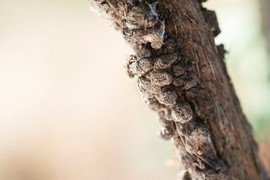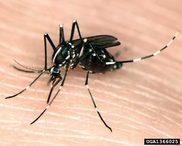|
Having trouble viewing this email? View it as a Web page.

|
|
|
Fresh from the Field is a weekly album showcasing transformative impacts made by grantees supported by the National Institute of Food and Agriculture.
NIFA
invests in and advances agricultural research, education, and extension and
seeks to make transformative discoveries that solve societal challenges.
July 20, 2017
|
|
Success Stories of the Week
 Oh the gall!
Crown gall disease is an
incurable malady that affects many woody and herbaceous plant species, such
fruit and nut trees, grapevines, and roses. The disease is caused by a
soil-borne bacterium, Agrobacterium tumefaciens that modifies the plant’s
genome and causes large, cancer-like tumors (galls) to grow at its base.
Given the economic impact
of this disease on growers, researchers at Oregon State University have
taken a major step toward developing an on-site detection tool for crown gall
disease.
With NIFA support from the
Specialty Research Crop Initiative and Agriculture and Food Research Initiative grant programs, the researchers developed molecular tools to work
with commercially available kits that allow the user to quickly and effectively
test plants for the disease, using a dipstick that reveals the presence of the
pathogen in minutes. Early and rapid detection of Agrobacterium is key to the
management of crown gall because there is no cure for the disease, noted Jeff
Chang, associate professor, and Elizabeth Savory, postdoctoral researcher, in
OSU’s College of Agricultural Sciences and coauthors of the study.
Read about crown
gall. Image
provided by Lynn Ketchum at Oregon State University.
|
 Mosquitoes without boundaries
The Asian tiger mosquito
(Aedes albopictus) thrives in temperate climates and is widely distributed in
the eastern and central United States as well as parts of the Southwest. The
species is adept at taking advantage of human-altered environments, and humans
are its preferred targets. The Asian tiger mosquito may be a vector for viruses
including dengue, chikungunya, Zika, and West Nile.
A team of scientists led
by Eliza Little, Ph.D., of Columbia University and Dr. Leisnham of the University
of Maryland, are looking at how socioeconomic, ecological, and climatic
factors interact to drive populations of the Asian tiger mosquito in an urban
environment.
Scientists know where to
find mosquitoes on larger spatial scales, such as counties or towns. But
habitat suitability for the Asian tiger mosquito varies at a much finer scale
than that, and control efforts need to happen at this same scale. Little and
colleagues looked at field-collected data on containers (potential mosquito
breeding sites), infrastructure, vegetation, precipitation, and abundance of
larval and adult Asian tiger mosquito across five neighborhoods of varying
socio-economic status in West Baltimore, Maryland. Their aim was to determine
which factors are present in city blocks with large mosquito populations. The
researchers found that the three most important variables for mosquito hotspots
were precipitation, number of abandoned buildings, and vegetation.
This research was
supported by the Hatch Multistate Research Fund.
Read more about mosquito habitat in Entomology Today. Image
provided by Susan Ellis, Bugwood.org
|
News Coverage
 No need for seeds in watermelon
Consumers love the
convenience and taste of seedless watermelons, and Florida growers are
responding to the demand by producing seedless cultivars. Yet, seedless
watermelon might be more susceptible to fusarium wilt, a major soil-borne
disease in Florida watermelon production, noted Xin Zhao, a University of
Florida professor of horticultural sciences and lead author of a new study
examining rootstocks, flavor and texture of watermelons.
University of Florida scientists have found a way to stave off potential diseases while
retaining that flavor.
Grafting is a useful tool
to manage soil-borne diseases, but in this study, researchers were concerned
that if they grafted watermelon onto squash rootstocks, they might reduce its
fruit quality and taste. Overall, study results showed no loss in taste and
major fruit quality attributes like total soluble solids and lycopene content.
This research project was
supported by NIFA's Specialty Crop Research Initiative (SCRI).
Read more about watermelons
at Laboratory Equipment. Image
provided by Xin Zhao at University of Florida.
|
The Library
 Risk management for
new farmers
Farmers face a number of
pressures, such as price, production, regulations, and financial risks. These
demands may inform their decisions on production and risk management.
The Extension Risk Management Education (ERME)
program, funded by USDA’s National Institute of Food and Agriculture provides
training to help producers learn new strategies to manage complex and growing
agricultural risks.
The ERME extension team developed a pilot
program on safe and appropriate pesticide use for Hmong produce growers in
Wisconsin. They modified the curriculum to present
information in a culturally appropriate manner, using native language,
visuals and hands-on activities when practical.
The program seeks to help producers
reduce crop losses and save money through reduced spraying. By knowing and
understanding the crop families, they will manage their pests more
effectively and protect themselves, their crops, and the environment.
As a result of this
outreach, 43 Hmong produce growers were reached. Seventy-seven percent of
the participants have applied new information and skills to their farming
operation. Twenty-three percent of the participants took the private
pesticide applicator test, and 67 percent of those passed the exam.
The research was
supported by the North Central Extension Risk Management Education Center in
Lincoln, Nebraska.
Read risk management newsletter.
|
Video
 The summer of plant defenders
While the human immune
system is adaptive, plants don’t have immune cells that can fight off
pathogens. In this video, YouTube vlogger The Simple Biologist, Katie Bredbenner, explains plant defense. She discusses a Duke
University project led by Dr. Xinnian Dong that uses gene editing to create disease-resistant plants.
Researchers identified the Natriuretic Peptide Receptor (NPR1) as beneficial
to achieve broad-spectrum disease resistance without affecting plant
growth and development. The researchers applied NPR1 gene to different gene
codes and discovered that plants go into defense mode without altering the
number of protein gene copies used to fight off the disease. Stronger plants may
result in reduction of pesticide usage.
This project was supported
through the NIFA Agriculture and Food Research Initiative (AFRI)
Watch the video.
|
Tweet of the Week
#NIFAIMPACTS

|
|

For more NIFA Impacts, visit nifa.usda.gov/impacts or the Land-Grant University Impacts website. Send us your NIFA-funded impacts at impactstories@nifa.usda.gov or share them with USDA_NIFA on Twitter #NIFAImpacts.
NIFA invests in and advances agricultural research, education, and extension and promotes transformative discoveries that solve societal challenges.
Fresh from the Field is a weekly compendium of news and information that may be of interest to land-grant and non-land-grant universities, NIFA stakeholders, and other subscribers.
Editor: Falita Liles; Co Editor: Carlos Harris
|
|
|
|